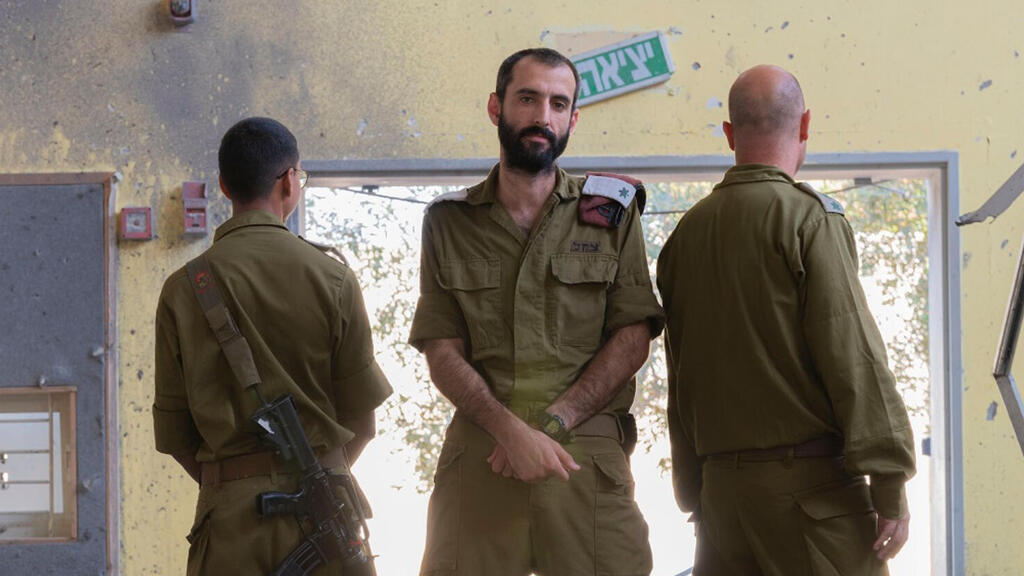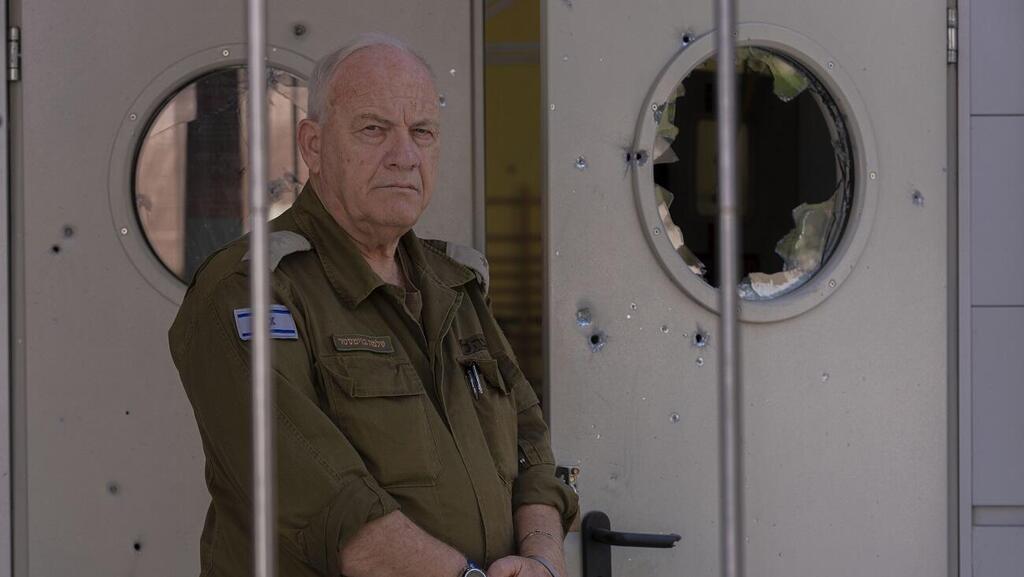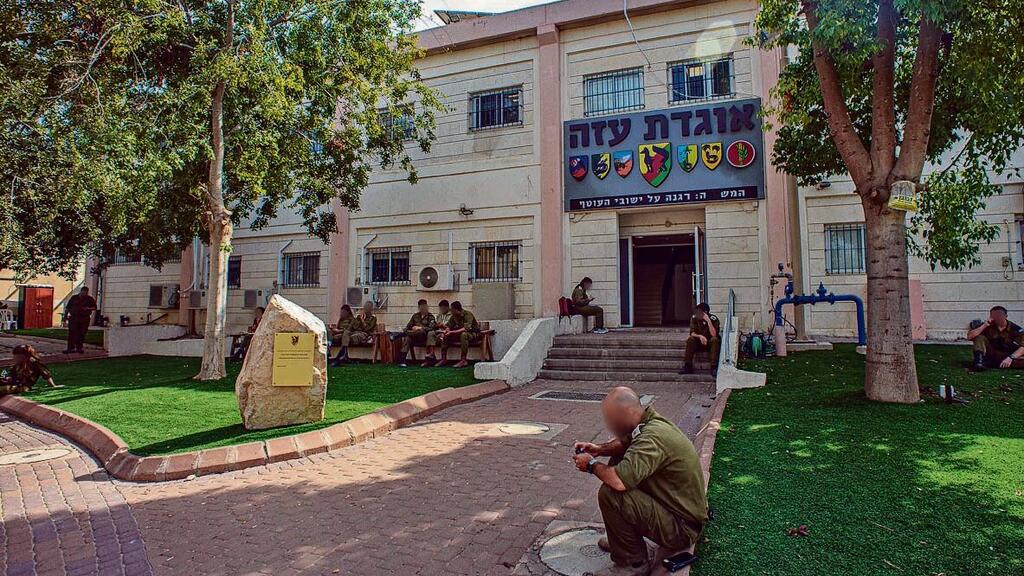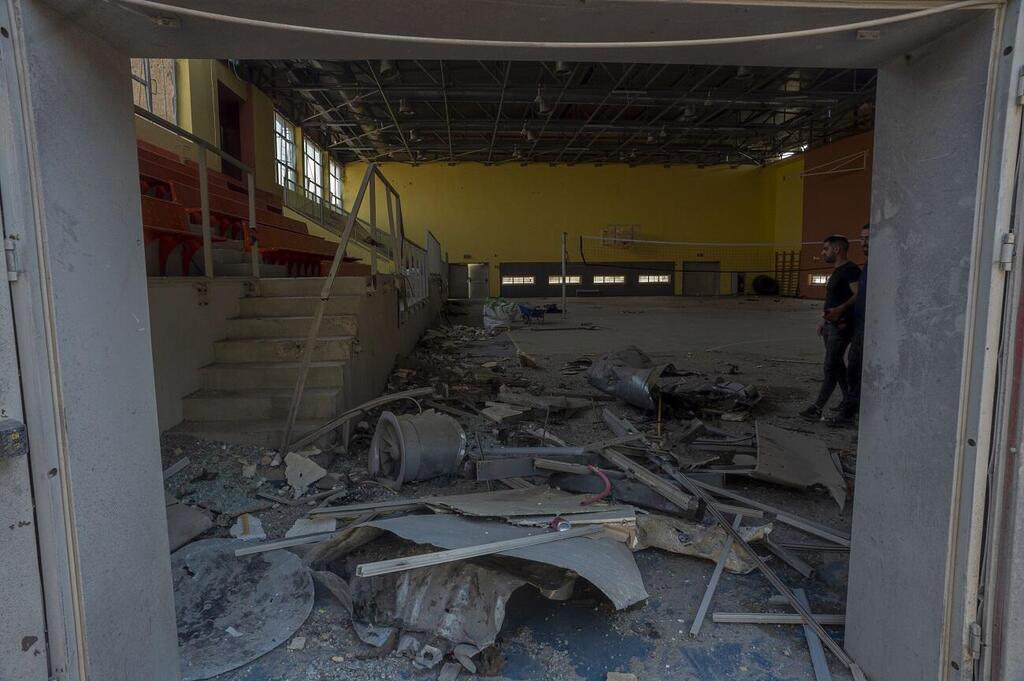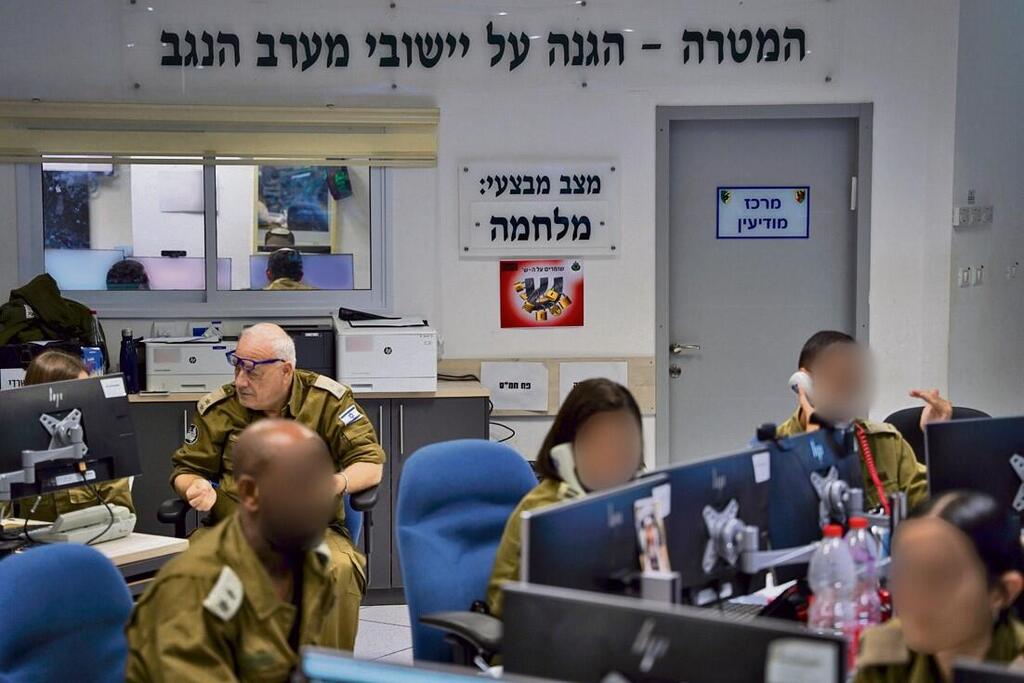On the Gaza Division’s operations room wall, a huge sign in bold letters reads the words: “The goal: Protecting the Western Negev communities.” One short sentence that says it all. This is the division’s purpose of existence. This sign serves as a pillar of fire guiding dozens of officers, soldiers, reservists, and security personnel, busily toiling away like bees in a hive.
Read more:
An outsider might get giddy. The bright neon lighting; battle logs, the constantly updated data charts projected in front of the central desk; plasma screens; the computers and red phones; and the sheer volume of ranks on the shoulders of the assembled personnel. But at the end of the day, within all this hi-tech, the most important thing is that sentence printed in the old-fashioned font: “The goal: Protecting the Western Negev communities.”
This sentence is a grim reminder to everyone here – those at the division headquarters on the morning of October 7, and those who joined later – that this goal is yet to be achieved. Everyone who was supposed to provide security to the residents of the Gaza Envelope, from most senior political echelons down to the officers in the field, failed in their duty. The terrible price of this failure, even if as yet not truly processed, is known to all.
More is yet to be told, described, and investigated, but in the Gaza Division’s operations room, right now they’re focusing on the present and the future, or in military jargon – Battle Management and Battle Procedure. And just for clarification, in case anyone was under the impression this was just another Gaza campaign or a round of fighting, another massive sign on the wall reads: “Operations Status: War.”
Lt. Col. (Res.) Shlomo Boimiester, the Home Front representative in the division’s operations room, is in no need of this reminder. What this nice grandpa did on that terrible Saturday morning, before reporting into the operations room, armed with a Kalashnikov he took from a dead terrorist and a Hamas flag he removed from a terrorist’s Toyota, will be written up in military history. He lives in Beersheba and is father to three and grandfather to five. His daughter, a career soldier, serves as a major in the division and his son-in-law is serving as a colonel in the reserves of another unit currently in the sector. When I asked him how old he was, he said: “67 and a half”. I commented that he hadn’t fought in the Yom Kippur War. He responded: “I had my own Yom Kippur on October 7th.”
He left his house for the division at 6:30 am, armed with a pistol and six bullets. “When I went through Ofakim, I saw a destroyed civilian vehicle at the junction,” recalls Boimiester. “I thought it was an accident, and then I heard gunshots. I parked my car at the side of the road and advanced in the direction of the gunfire. I saw two policemen, one in shorts. Then there was very heavy gunfire towards us. There were at least three terrorists. We repelled them and then one of the terrorists popped up from between two cars, shot at us, hitting me in the groin. The bullet that hit me, ricocheted onto one of the policemen, severely injuring him in the knee. We put a tourniquet on him and a Hatzalah team evacuated him to Soroka Hospital. There was a huge commotion at the hospital. I, very politely, managed to convince the doctors to treat me immediately so that I could get back to the division as soon as possible. I asked my partner to bring me a new pair of pants as my pants had been torn by the gunfire and were full of blood. They dressed my wound with six clips and I went back to the division.”
On his way to the headquarters at the Re’im base, Boimiester passed the scene of the massacre at the Nova festival. “I didn’t know about the incident until then. There was still heavy gunfire going on. We set up a reception point at the junction at the entrance to Kibbutz Re’im, and when special forces passed by, I asked them to send us survivors. A lot of young people who’d managed to flee the massacre were brought to us, some injured. We put them into civilian vehicles and sent them to the gas station at Urim junction. I then drove to Urim Junction myself and saw that the gas station was full of civilians. Realizing this was dangerous, I loaded them onto a bus and sent them to Ofakim.”
Only then was he free to drive to the division headquarters. What he saw on the way was horrendous. “There were lots of bodies by the side of the road. I got here while the fighting inside the base was in full swing. Reinforcements from the IAF’s Shaldag unit had already shown up. I took a pistol and a magazine from a dead terrorist and I defended the entrance on my own. I knew that I had to be in the operations room and help manage the division’s fighting.”
As the gunfire was dying down, he made his way to the operations room complex, which was locked, fearing terrorists would try to break in. “On my way to the division, I gathered information and data for intelligence purposes. They let me in. When I asked where Avi (division commander Brigadier General Avi Rosenfeld) was, I was told he was in the commander’s operations room. I went to him and he said, ‘Go to the central desk and help manage the fighting.’ I did this from that moment through to Sunday morning. My team included the division commander, two female operations room officers, four female communication officers, and another four female officers, including a division representative of the IDF Spokesman’s office. The Intelligence officer at the central desk, liaising between us and all the intelligence, was still dressed in red pajamas. “
As it all occurred on Shabbat, the division headquarters had a very limited team. Protocol dictates that, on weekends, a senior officer remains on base to command the sector. By chance, on October 7th, it was the division commander himself. Operations Officer, Maj. Hanan Mor was on the base as an operations branch headquarters duty officer, also serving the rest of the division’s wings.
Mor, 35, a married father of three, lives in Leshem in the Shomron. He was raised in the Kfir Brigade and came to the division after serving as a battalion sergeant in the Golani Brigade. His responsibilities include operating the division's operations room.“ At 6:30 am, there were siren alerts and rockets started landing on the base,” he recalls. “Although I didn’t have much to update him, I called the division commander, while running to the shelter next to the officers’ barracks. I started getting reports from the operations rooms about drones, paragliders, etc., crossing the fence. I notified command and ran to the operations room, rockets landing all around. We opened the commander’s operations room and started gathering data. “
When did you realize the magnitude of the situation?
Mor: “We very quickly formulated an, albeit incomplete, Situation Assessment. Most of the reports we were getting were from the communities, as the division’s security forces were engaged in fierce fighting. Our task was to bring as many forces as possible to the communities and use the air force most effectively. I told the Home Front officer and another officer to keep an eye on the reports from the communities and try to assess where the most complex incident was, so that we would know where to send the first forces that showed up in the sector. A great deal of forces started arriving. Someone from Sayeret Matkal General Staff Reconnaissance Unit called and I told her where to send teams. We also tried to put as many combat helicopters and unmanned Zik drones on the incident. We knew that it would be very hard to operate inside the communities under fire, so I told the duty operations officer ‘Let’s bring as many forces as we can to the communities and what we have in the way of aerial fire – helicopters, drones, etc. we’ll take to the breaches in the fence, where we can fire more effectively.’ “
“And as if that wasn’t enough, at a certain point, the division trackers officer reported that there was fighting against the guardsmen at the entrance to Rei’m base. I told him to gather anyone who had a gun, and that from now on, his task was to defend the base. I was the only one in the operations room who was armed. I wanted to go with him, but the division commander said he needed me here. I gave my gun to the liaison battalion commander, Lt. Col. Sahar Machlouf. He went out to fight the terrorists and was killed. “
As a combat soldier, and a combat commander, a former Golani sergeant, staying in the operations room must have been frustrating while there’s a battle going on outside with terrorists and you need every fighter.
“Yes. It was very frustrating. I’ve always served as a combat soldier, not as staff and my instincts were to take a gun and get out there. Looking back, I think my contribution in formulating a division Situation Assessment, directing fire, and sending forces to communities was greater than another barrel out in the field. “
“Lt. A, Division Assistant Intelligence Security Officer, wasn’t supposed to be part of it. He was attached to us to ensure we didn’t expose classified information. But then, on this Shabbat morning, this young officer, with no combat experience and the most basic of rifle training, took part in fierce fighting against terrorists trying to take over the division base. “
“I was the duty officer that weekend on base. I was responsible for security and for the alert team,” he tells us. “The sirens woke me at 6:30 a.m. and I got into the shelter. The rocket fire continued for 40 minutes and then I went out with the alert team to survey the base to make sure no one was injured by the rockets and that all the guardsmen were alright. The guard at the gate was in a shelter and I asked him to join me. We advanced towards the gate where we met the trackers officer with some of his men. He warned us that there were terrorists outside and told us to take cover and start shooting. A gun battle ensued with us inside the base, behind walls, and the terrorists outside, in front of the gate. They left their motorbikes and vans in the parking lot outside and started advancing toward the gate, shooting with firearms, RPGs, and grenades.”
How many of you were there?
“We were a small force, the minimum security in the division. We had the trackers – who are combat and the alert team consisting of headquarters personnel. I had a human resources officer with me. Anyone who had a gun took it with both hands and we fought as we were calling into the operations room to send us more forces. At the time, I didn’t know it like that throughout the sector and that there weren’t too many forces that could come to help us. In the meantime, we see the terrorists break up - left and right outside the base and we realize that they intended to breach the fence and enter from two directions. So, our force also split up – one part went to the southern section, one to the north. At the gate, we were left with four men: Myself, Udi the human resources officer, and two trackers. I suddenly get a phone call from a friend at home telling me that three of his friends on the base are in the men’s bathrooms and that one is injured. It looks like there are terrorists there and they need help. These were combat soldiers from the command post. “
And then, you realize that there are terrorists inside the base
Lt. A: “Yes. The human resources officer advanced towards the barracks to help the besieged soldiers. We flanked the walls and when we made it to the barracks, we saw a dead terrorist and a command post soldier who had also been killed. As I only had one magazine, I took magazines from the soldiers there. From outside the barracks, we suddenly hear shooting and shouting in Arabic. There was a fence with a small opening between us and the terrorists. We lay down next to the opening and shot at them. They fired back, and we took cover for two minutes. There were five or six terrorists there – and that’s just one spot. We went to the Northern Brigade office and up to the second floor to see what was going on from above, but when we got to the building, I realized the terrorists were inside. We ran to the division commander’s building, went up to the office, and barricaded ourselves in there until the Shaldag forces arrived.
Hanan: “At first, one Shaldag team arrived, but there were dozens of terrorists in the base and the guys from Shaldag didn’t manage to overcome them. Then we were allocated another team from the unit. I wanted to send the unit to one of the communities because our foremost task is to take care of the residents. The division’s operations officer, who had come from home, set up an alternative operations room at the Urim base and had sent them here. At 13:40, the second team arrived. The fighting ended here at about 4 p.m. In hindsight, I think the operations officers’ decision was correct. Yesterday, the division’s logistics officer said to me ‘You do realize that we were moments away from being like Nahal Oz.’ “
As we know, at Nahal Oz the terrorists went on a rampage of killing and kidnapping and they broke into the operations room
One of the female officers who was in the division’s operations room during those hours describes how it felt: ”We already knew what had happened in other places where terrorists had taken over. There were moments when I wondered to myself what I would do if they broke into the operations room. I’m sure everyone here was thinking the same. But we also saw guys fighting outside and they’d periodically come into the operations room to update us. They would fight until the last drop of blood to defend the division operations room.” The operations officer notes that the division’s operations room functioned throughout the fighting.
That isn’t what people sitting at home, or those besieged in safe rooms pleading for help, were feeling that day. Even afterward, we were hearing claims that the division headquarters wasn’t operational, that communication with the operations room was cut off, and that no one was managing the campaign.
Hanan: “I can tell you that the operations room functioned very well, despite fighting within the sector and we could hear the gunfire. We locked the operations room and carried on working. At no stage did the operations room stop working. I don’t remember a single moment when we lost control. I’m not surprised, because I know the female officers and sergeants. Our main problem was that we didn’t have a lot of forces in the field, so we were mainly dealing with absorbing forces from the outside and directing them to the communities. And that took time.” He showed me his phone. “Here’s the tracking chart of the forces we sent to communities.”
You were sitting in the operations room with cell phones?
Hanan: “Definitely not, but when we understood that most of the reports were coming in from civilians in the field, we realized that this was our best method of communication and we brought in cell phones. We were getting a lot of reports from people in safe rooms in communities who were sending us locations, or people from the festival writing to us, ‘We’re here hiding under a car’ or ‘We’re hiding in the bushes’ and so we sent forces to help them. “
Shlomo Boimiester also believes the division operated very well. “The division commander was in the operations room, constantly being updated on the Situation Assessment. He gave instructions and managed the fighting. We got a lot of information from the media and Dorin, the division spokeswoman, gave us valuable information too. We cross-referenced the information and acted according to priorities. The division commander knew how bad the situation was, but Calmy made decisions.”
This is the first time a journalist has been permitted to visit the division's operations room since the beginning of the fighting. It’s not, however, my first visit. I served for 17 years as a reserve duty officer in the division’s operations branch before disengagement, when it was still situated in Gush Katif. When Re’im base was established for the division’s headquarters, a reinforced concrete operations complex was built at its center. I was based here during Operation Protective Edge in 2014. I remember the moment the observer in the Southern Brigade identified terrorists coming out of a tunnel. A few seconds later, live on a plasma screen, we saw them coming out of the tunnel one after the other, next to Kibbutz Sufa. One, two, three, four… in total, twelve terrorists. “
“At that moment, it was inconceivable. No one could have imagined that there would come a day when not twelve, but 2000 terrorists would infiltrate Israel. No one could have envisioned the horrific acts they carried out. No one could have thought of over 1500 murdered and fallen, and over 200 kidnapped. Commissions of inquiry will investigate the division’s operations and the conduct of senior officers on that terrible day, and they should investigate. But three weeks later, I see bleary-eyed, tired people in the operations room, including Maj. (Rrs.) Amir and Maj. (res.) Yishai who has served with me in the reserves for years, I feel nothing but respect and appreciation. I’m not sure I could take the mental and emotional pressure of managing the fighting of a division hit so hard. “
The operations room commander is just one part – albeit central – of the operations rooms. On a tour the division spokeswoman conducted for me, we visited the field artillery center responsible for operating the drones, helicopters and warplanes, precision-guided weapons, etc. It’s the same size as the commander’s operations room and has dozens of officers and soldiers sitting in it. The field artillery commander, Maj. Gen. (Res.) Y. has served in senior positions in the Armored Corps and is now a civics teacher, educator, and class coordinator at a school in Mod’in. “On Saturday morning, we quickly arrived at the Southern Command headquarters in Beersheba and opened a division attack team alongside the Shabbat duty officers who managed the Re’im field artillery center. We operated everything: Drones, helicopters, fighter jets. They very quickly ran out of ammunition and had to be rearmed. “
Everyone watching the swarms of people crossing the breaches in the fence was asking themselves where the Air Force was
“We had plans in place for such an incident. Everything worked according to plan,” says Maj. Gen. Y. “It’s just that the plans didn’t involve such a great number of terrorists, communities, and breaches in the fence. In such a situation, you’re forced to drop tiny amounts in each place. We quickly realized that we couldn’t operate the air force inside the communities, as it’s so hard to know which are our forces, and which are the enemy. So, we concentrated our fire around the fence and outside the communities. Anything that could fire, fired. Our task was to prevent a second wave of infiltrations into Israel, and if there was such a plan, we averted it. We managed to stop a lot of terrorists on the fence – and some we didn’t.”
Wasn’t it frustrating?
“Yes. Very. But you work automatically.” Hanan: “We’re now finding a huge number of bodies of terrorists at the fence, and it reinforces what the field artillery commander said. The decision to send the helicopters and drones to the fence to avert a second wave of hundreds more terrorists has proven itself.”
There’s a sign on a door in the operations complex reading “Holy Works Complex.” This team, founded at the outbreak of the war, coordinates the hardest work of all: locating the bodies of soldiers and civilians in the field. The complex commander, the lieutenant colonel who set it up, comes out of the room and walks down the corridor. His burnt eyes tell us everything we need to know to understand the horrors he’s witnessed over the past three weeks.
“This is what holy work is,” says Lt. Col. Boimiester. “The division invests huge efforts, including operational efforts, beyond the fence, risking human life, to bring everyone home to be buried in Israel. We’ve dealt with hundreds of locations and we’re now down to the last few dozens of missing persons.”
Hanan: “Our efforts to search and locate bodies are being conducted alongside the fighting. Both are independently complex, and the combination of the two is even more complicated. It’s mentally very hard to collect so many fallen soldiers.”
Aerial photography is also being used to locate bodies: “We’re dealing with this indefinitely, on a personal level, in terms of names. We need to find the people we are indebted to, to know what’s on the other side and what’s on our side,” explains Maj. Gen. Y.
On another door in the operations complex, hangs a sign reading “Nahal Oz Operations Room is Our home.” The door is decorated with children’s drawings and letters of support. The observers’ operations room was transferred here. Most of the female soldiers who staffed it were murdered or kidnapped. It’s now maintained by their friends who were at home on that Shabbat and whose lives were saved, alongside reserve duty observers.
50 feet from the operations room is the battleground. Dozens of terrorists barricaded themselves in this fancy sports hall and the high-end gym. They conducted a gun battle for hours with Shaldag fighters and the evidence of the fighting is clear to see. All the glass is smashed, the sports hall walls are riddled with bullet holes, and the gym equipment is covered in dust. The battle came to an end when a helicopter shot a missile into the gym where the remaining terrorists were barricaded. They’ve only just started clearing the ruin. A lot more work needs to be done before the gym will look like it did before.
But the sports hall is the last thing on the minds of the Gaza division officers. As they tirelessly work to stabilize the defense line and prevent further infiltrations, the division is planning for the next stage in the operation. In Operation Protective Edge, the Gaza division took part in maneuvering inside Gaza but, this time around will stay on this side of the fence.
“Our task, alongside defending the settlements, is to facilitate maneuvering,” explains Maj. Mor. “We will support everyone going in, and we’ll do it in the smoothest and safest way possible. We are the home division, and allowing other forces to enter the strip is a complex task.”
The Gaza Division field artillery center has been working around the clock for the past three weeks. “We’re attacking their territory,” says Maj. Gen. Y. “There are places we’ve informed the population that they can be and that anyone walking around near the fence will be killed.”
What is the division of responsibilities between the command and general staff in terms of attack?
“Firstly, there’s a geographic division along the fence. Secondly, the command and the general staff deal with defense, eliminating senior commanders, etc. The people I attack have no names. As far as I’m concerned, any Hamasnik is a target.”
And you’ll continue with these attacks even when the ground invasion broadens?
“We’ll carry on to the very end.”


